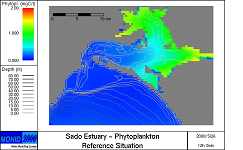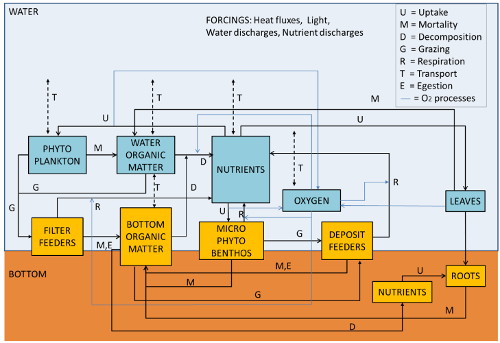MOHID Water
Water Quality

MOHID Water is prepared to simulate properties such temperature, salinity, cohesive sediments, phytoplankton, nutrients, contaminants, etc. These properties can either be (i) dissolved in the water, therefore following the currents; (ii) particulate phase or adsorbed on to particulate matter, thus being subjected to one more transport variable: the settling velocity. This enables particulate properties to deposit in the bottom and thus become a part of the sediment compartment. Sources and sinks relate to reaction processes taken place inside the assumed control volume, which undertakes local production and destruction terms. The sink and source terms can be computed by MOHID in the pelagic (water column) and benthic (on/inside the bottom sediment) systems.
The pelagic water quality processes can be simulated in MOHID with two different modules, differing mainly in terms of processes description complexity level:
- Module WaterQuality (WASP-type): This module is basically a nutrient-phytoplankton-zooplankton-detritus (NPZD) model adapted from a model initially developed at USEPA (U.S. Environmental Protection Agency) (Bowie et al., 1985a). The model considers 18 properties, including nutrients and organic matter (nitrogen, phosphorus and silica biogeochemical cycles), oxygen and organisms. The model enables the user to choose between the simulation of one group of phytoplankton (for simple applications) or two groups (for more complex applications) – flagellates and diatoms. The same type of option is made for secondary producers: one generic group of zooplankton or two groups – microzooplankton and mesozooplankton. The model is also able to simulate heterotrophic bacteria in the water column.
- Module Life (ERSEM-type): This is a more complex model, able to simulate not only nutrients (nitrogen, phosphorus and silica biogeochemical cycles) but also several species of primary producers, secondary producers and decompositors in the water column. The model computes the variability of N:P:C content in the organism’s tissue. More complex and detailed studies can be performed using this model. Greater detail in the conceptual model and equations of this module can be found in Mateus (2006)b

The MOHID model also simulates the benthic processes of seagrasses, microphytobenthos and filter feeders. This module is integrated in the MOHID water and uses the pelagic model Water Quality (IST, 2006c) and thus is able to provide a more comprehensive representation of marine ecosystem dynamics in coastal and estuarine waters. Grazing on phytoplankton and particulate organic matter in the water column by filter feeders is included and can affect the light extinction processes. Greater detail in the conceptual model and applications of this module can be found in Ascione Kenov (2014)d
As light availability is a crucial variable for the primary production whether in the water column or benthos. The parameterisation of its extinction has been treated accordingly in the MOHID model where it can be defined as a function of sediment concentration, chlorophyll concentration or both.
Numerical Characteristics
Main characteristics | |
|---|---|
| 0-Dimensional pelagic water quality | Independent of the referential dimensions, water quality modules are computed for each control volume allowing to couple to any transport module:
|
| Analysis tools for water quality modelling results | Model results can be obtained as:
|
| Short wave light extinction parameterisation | Based in the concentration of the following components:
|
References
aBowie GL, Mills WB, Porcella DB, Campbell CL, Pagenkopf JR, Rupp GL, Johnson KM, Chan PWH, Gherini SA and Chamberlin CE (1985). Rates, constants, and kinetic formulations in surface water quality modeling. U.S. Environmental Protection Agency.
bMateus M (2006). A process-oriented biogeochemical model for marine ecosystems: Development, numerical study and application. PhD thesis. Technical University of Lisbon, Portugal. Available for download here
cMOHID WaterQuality Module Manual (2006). Available for download here
dAscione Kenov I (2014). Development and application of a process-oriented model for benthic marine systems. PhD Thesis, Instituto Superior Técnico, Universidade de Lisboa, Portugal. Available for download here
eParsons T, Takahashi M., Hargrave G (1984). Biological Oceanographic Processes. Pergamon Press, New York, 330p.
fPortela LI (1996). Mathematical modelling of hydrodynamic processes and water quality in Tagus estuary. PhD Thesis, Universidade Técnica de Lisboa, Instituto Superior Técnico, Lisboa, Portugal. Available for download here
gLight parameterization in MOHID (2011). Available for download here


